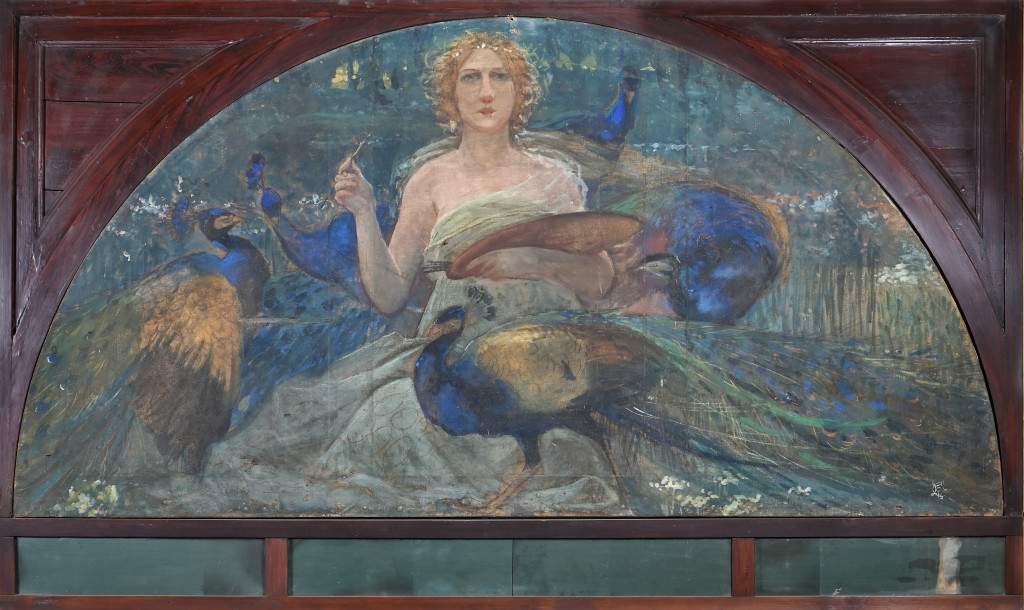From September 14 to October 11, 2020, the exhibition Manifattura Chini is open to the public. Unpublished Works from the Marianna Mordini Collection at the Palazzo delle Esposizioni in Lucca. The exhibition, curated by Vittorio Sgarbi, is produced by Contemplazioni and promoted by Fondazione Banca del Monte di Lucca and Fondazione Lucca Sviluppo, and also enjoys the patronage of the City of Lucca.
The exhibition delves into the artistic production and tradition of the Manifattura Chini with particular attention to the activity of Galileo Chini (Florence, 1873 - 1956) among the most multifaceted artists of the Liberty season, who had the right sensitivity and intuition to ensure that Italy, too, witnessed the renewal in the applied arts that was so popular in late 19th-century Europe. Chini also developed his creativity in ceramics, founding in Florence L’Arte della Ceramica, a small manufactory together with Vittorio Giunti, Giovanni Montelatici and Giovanni Vannuzzi. From here their activity experienced a rapid rise, especially for the originality of their productions. Various vicissitudes later led Galileo to found a new family-run business near Borgo San Lorenzo: the Fornaci San Lorenzo. Production expanded with the working of glass to produce important stained-glass windows as well as chandeliers and table lamps. Then came the production of copies of works of the past and again the countless and very elegant architectural designs. An endless quest for beauty that continues to this day in his work.
“In the art of Galileo Chini and the Manifattura,” says collector Marianna Mordini, “I breathed in the arias of Giacomo Puccini, with whom he collaborated in the creation of extraordinary stage sets, I have admired the green landscapes of the countryside by the sea, traveled through oriental atmospheres and views of Florence with dizzying perspectives, collected drawings of popes and saints, and ventured into the architecture and designs for large hotels and spa places, where the smallest detail is an escape to greatness.”
Unmissable among the works on display are the ceramics, the undisputed protagonists of Chini’s production, understood either as a work of art divided between the copy of the past and the very modern style, or as the very first forms of design (vases, plates, and other objects of common use), or as colorful and triumphant decorative elements. Preparatory studies include the chess series, probably designed for a game room; and the Chinoiserie series, with figures drawn in their typical costumes within oriental landscapes with simple, highly evocative features. Staying true to the passion for the Orient, the Manufacture also decided on the production of a type of cache-pot called Cio Cio San intended to contain plants that would serve as foliage for its broad head.
Allegories of the seasons and scenes of rural activities such as olive harvesting, chopping wood or threshing wheat on the threshing floor feature prominently in a series of studies made in the late 1930s probably for some of the decorations for the Castrocaro Baths. Then recurring are the landscapes that become true scenic images for accuracy of detail and their articulation.
As evidence of the heterogeneity of the Manifattura Fornaci San Lorenzo’s production, a multiplicity of projects and architectural studies intervene, ranging from the study of stained glass windows to sketches for the decoration of the Prato railway station or, again, for the extensive cycle of frescoes for the Pisa Chamber of Commerce.
In the exhibition itinerary, works from the Mordini Collection dialogue with two large oil paintings from the Cavallini Sgarbi Foundation-The Stillness and Still Life with Hare, Apples and Carrots, Pot and Bottles-and again with Allegory of Painting, a masterpiece belonging to the Vieri Chini Collection, which, together with other ceramics and drawings, contribute excellently to show the versatility of Galileo Chini and highlight the breadth of his production.
Admission to the exhibition is free.
Pictured: Galileo Chini, Allegory of Painting (ca. 1895; canvas, 97 x 191 cm; Vieri Chini Collection)
 |
| Lucca, the history of the Chini factory on display with works from the Mordini Collection |
Warning: the translation into English of the original Italian article was created using automatic tools. We undertake to review all articles, but we do not guarantee the total absence of inaccuracies in the translation due to the program. You can find the original by clicking on the ITA button. If you find any mistake,please contact us.